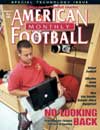AMERICAN FOOTBALL MONTHLY THE #1 RESOURCE FOR FOOTBALL COACHES
Article CategoriesAFM Magazine
|
Cutting the ChordFrom the Coaches Office to the Mobile Officeby: Rod Smith © More from this issue Coaching great Knute Rockne is known for his motto "Winning - it's not everything ... it's the only thing." But as any successful coach can tell you, perhaps the only thing you can really count on are the long, often tedious hours. No one needs to remind you that coaching is a time-consuming profession. You've been there. Late nights followed by early mornings. And if by some miraculous intervention more hours were added to the day, you'd probably just spend this surplus time in your office, right? Besides, that's where your computer is; that's where you edit film; that's where you print out next week's scouting reports; and that's where you draw up game plans, weight workouts and practice agendas, right? Thanks to technology it doesn't have to be this way, though. Anymore, technology applications are just as likely to liber....The full article can only be seen by subscribers.
|
|
|||||||
| HOME |
MAGAZINE |
SUBSCRIBE | ONLINE COLUMNISTS | COACHING VIDEOS |
Copyright 2025, AmericanFootballMonthly.com
All Rights Reserved





